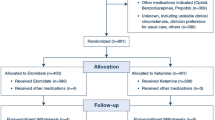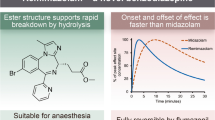Abstract
Background
Acoustic noise may have adverse effects, even in patients under general anesthetic.
Objective
We aimed to determine the effect of headphones on sevoflurane requirements in children undergoing general anesthesia for an MRI scan.
Materials and methods
Children scheduled for MRI were enrolled in the study. Sevoflurane was used for general anesthesia in all children. Patients were randomly divided into two groups, one to wear headphones and the other none. After reaching a predetermined end-tidal concentration, the MRI scan was initiated, and the patient was evaluated by an observer blinded to the concentration of sevoflurane. Awakening was defined as eye opening, onset of continued purposeful movement or phonation. Using the Dixon up-and-down method, each target concentration was determined by the response of the previous child in the same group.
Results
The study included 28 children undergoing MRI. There was a significant difference in ED50 between the two groups (0.92, 0.81–1.02, vs. 0.47, 0.42–0.63; P < 0.001). The times to spontaneous arm and leg movements, eye opening and discharge from the post-anesthesia care unit were significantly shorter in patients with headphones than in those without (P < 0.001). However, there was no difference in times to hospital discharge (P = 0.056).
Conclusion
Noise-concealing headphones decrease inhalational anesthetic requirements and facilitate recovery. We recommend the routine use of headphones in children undergoing an MRI scan.


Similar content being viewed by others
References
Schulte-Uentrop L, Goepfert MS (2010) Anaesthesia or sedation for MRI in children. Curr Opin Anaesthesiol 23:513–517
Serafini G, Zadra N (2008) Anaesthesia for MRI in the paediatric patient. Curr Opin Anaesthesiol 21:499–503
Beauve B, Dearlove O (2008) Sedation of children under 4 weeks of age for MRI examination. Paediatr Anaesth 18:892–893
Hattori Y, Fukatsu H, Ishigaki T (2007) Measurement and evaluation of the acoustic noise of a 3 Tesla MR scanner. Nagoya J Med Sci 69:23–28
Harned RK 2nd, Strain JD (2001) MRI-compatible audio/visual system: impact on pediatric sedation. Pediatr Radiol 31:247–250
Oğurlu M, Orhan ME, Bilgin F et al (2010) Efficacy of different concentrations of sevoflurane administered through a face mask for magnetic resonance imaging in children. Paediatr Anaesth 20:1098–1104
McJury M, Shellock F (2000) Auditory noise associated with MR procedures: a review. J Magn Reson Imaging 12:37–45
Occupational Safety and Health Administration (OSHA) Occupational noise exposure, 29 CFR, Part 1910.95 (1988)
Food and Drug Administration (1988) Magnetic resonance diagnostic device: panel recommendation and report on petitions for MR reclassification. Federal Register 53:7575–7579
Brummett RE, Talbot JM, Charubas P (1988) Potential hearing loss resulting from MR imaging. Radiology 169:3539–3540
Quirk ME, Letendre A, Ciottone RA et al (1989) Anxiety in patients undergoing imaging. Radiology 170:463–466
Brennan SC, Redd WH, Jacobsen PB et al (1988) Anxiety and panic during magnetic resonance scans. Lancet 2:512
Lemaire C, Moran GR, Swan H (2009) Impact of audio/visual systems on pediatric sedation in magnetic resonance imaging. J Magn Reson Imaging 30:649–655
Raschle NM, Lee M, Buechler R et al (2009) Making MR imaging child’s play – pediatric neuroimaging protocol, guidelines and procedure. J Vis Exp (29),e1309. doi:10.3791/1309
de Bie HM, Boersma M, Wattjes MP et al (2010) Preparing children with a mock scanner training protocol results in high quality structural and functional MRI scans. Eur J Pediatr 169:1079–1085
Davidson AJ, Wong A, Knottenbelt G et al (2008) MAC-awake of sevoflurane in children. Paediatr Anaesth 18:702–707
Hui MT, Subash S, Wang CY (2011) The 50% and 95% effective doses of desflurane for removal of the classic laryngeal mask airway in spontaneously breathing anaesthetised adults. Anaesthesia 66:274–277
Conflicts of interest
The authors have no conflicts of interest to report.
Author information
Authors and Affiliations
Corresponding author
Rights and permissions
About this article
Cite this article
Oğurlu, M., Orhan, M.E., Çinar, S. et al. Effect of headphones on sevoflurane requirement for MRI. Pediatr Radiol 42, 1432–1436 (2012). https://doi.org/10.1007/s00247-012-2463-6
Received:
Revised:
Accepted:
Published:
Issue Date:
DOI: https://doi.org/10.1007/s00247-012-2463-6




